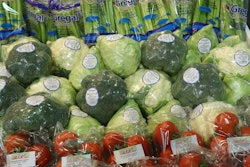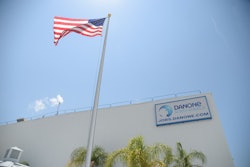
Even before the Tillamook County Creamery Association’s (TCCA) founding in 1909, its hometown of Tillamook, Ore., was innovating ways to bring dairy to the masses.
That’s how the brand’s ship logo on each package came to be: Tillamook County dairy farmers in the mid-1800s struggled to deliver their cheese and butter products to Portland across rough, mountainous terrain, so they looked to the water for a path forward, the company says. After trial, error, and a few unfortunate wrecks, these dairy farmers had themselves a seaworthy ship ready for the journey. It was dubbed The Morning Star of Tillamook on January 1, 1855, and soon began the journey to deliver its first batch of Tillamook dairy to Portland, by way of the Columbia River.
Now in 2025, TCCA is continuing the legacy of The Morning Star on its package with a new ice cream manufacturing plant in Decatur, Ill. The expansion is TCCA’s first facility outside of Oregon and comes about eight years after TCCA’s 2017 decision to grow its reach beyond the Western U.S. It also follows ice cream sales of about 27 million gallons in the U.S. in 2024 alone, reaching around 15 million households, says David Booth, TCCA President and CEO. David Booth, President and CEO of TCCA, kicked off the opening day by explaining the company's growth strategy in the ice cream space.
David Booth, President and CEO of TCCA, kicked off the opening day by explaining the company's growth strategy in the ice cream space.
“You would think a majority of that was in the Western part of the U.S., but honestly, today, we sell more to households in the Eastern U.S.,” says Booth. “You can see the importance of building this facility in Decatur, to get closer to our customers and consumers, it’s so important.”
An ice cream plant in Decatur: a familiar sight, with a new commitment
The plant is just under 60,000 sq ft, nestled among homes, and not far from Decatur’s downtown. It doesn’t fit the stereotypical picture of an all-new manufacturing plant towering over rural land or among other large buildings in an industrial park, and there’s a unique story behind that.
This building is more than 100 years old, and before it spent some time vacant ahead of TCCA’s arrival, it was also an ice cream plant. And like the story of the Morning Star and the challenges Tillamook’s dairy farmers faced, TCCA faced significant hurdles making this plant ship-shape to meet East Coast demand.
“This is not an easy project; it would have been much easier to do a greenfield project. There were so many unknowns, so many challenges with the structure of the building,” says Mike Bever, Executive Vice President, Chief Supply Chain Officer at TCCA.
While the building had good bones, it took an investment of around $65-70 million to bring it up to modern manufacturing standards.
 TCCA spent around $65-70 million renovating the plant with new concrete, structural steel, and automation.
TCCA spent around $65-70 million renovating the plant with new concrete, structural steel, and automation.
The renovation job also involved adding significant new automation to meet modern ice cream manufacturing standards, as well as changes like opening windows to let in more natural light for employees.
Part of the strategy in building this new facility was to shift the balance of TCCA’s internal and external manufacturing network toward more internal production, according to Bever. Bringing more operations in-house “allows us to control quality and make sure every single container of ice cream that comes out of here meets or exceeds the Tillamook expectations,” he says.
But reaching this bar for TCCA quality can’t be achieved with some new concrete and machinery alone.
“Our success will be determined by our ability to infuse the Tillamook culture here in Decatur, and that’s hard to do,” says Bever. “I will tell you, we do things differently. The way we treat our employees; we do things that we don’t have to do, we do things because it’s the right thing to do. And it’s working; our employees are responding well to it, and we will continue to double down, and that will determine our success here.”
To import that TCCA culture to the new plant, the company brought in experts from the Oregon facility to help train employees and set up operations. Oregon-based team members ensured the new plant would have the same quality standards, recipes, and ingredients as back home to produce the same quality ice cream.
TCCA collaborated extensively with the City of Decatur to complete the renovation, “And the city management has been absolutely fantastic,” says Bever. “I’ve had a monthly call with [Nicole Bateman, President at the EDC of Decatur and Macon County] and the city for three years. The way those calls go is, ‘So Mike, tell us what you need. What can we do, and what obstacles can we help you remove?’ Without that, this facility wouldn’t be here.”
Decatur welcomed the company and the opportunity to transform this once-vacant building with it. “When you know what this area looked like before Tillamook, and now you see what we have… The vision was incredible, and this has absolutely transformed this part of town,” says Julie Moore Wolfe, Mayor of Decatur.
In turn, TCCA aims to be more than just another business operating in the area. With the help of JP Cullen, TCCA’s general contractor for the project, the company is committing $50,000 in donations to support the local community in Decatur. Funds will go toward programs and services like the Decatur Park District and local food security efforts.
Watch the below video to follow ProFood World along for the plant's opening day tour.
A look inside TCCA’s Decatur ice cream operation
Stepping inside the Decatur plant, signs of the building’s true age are minimal.
TCCA designed the office and breakroom spaces with a material palette of plywood, corrugated metal, and tile—consistent with the company’s aesthetic at other facilities and nodding to the materials common in a typical farm. Construction elements in the packaging and processing spaces, like much of the concrete flooring and stainless-steel surfaces, appear brand new and ready for the production ahead. TCCA's Decatur office space is designed with materials typical in a farm setting.
TCCA's Decatur office space is designed with materials typical in a farm setting.
Plans for production in this space are lofty; TCCA plans to produce about 3 million gallons of ice cream here in the first year and ramp up to 15.5 million gallons at full capacity over the next several years, Bever says. “Overall capacity here is significantly greater than our ice cream plant in Oregon,” he adds. “It will be more than double the capacity of that plant.”
The plant’s workforce is also slated to ramp up, starting with 50 new jobs in the area upon opening, and rising as the company reaches for that 15.5-million-gallon capacity.
TCCA sources its raw materials either from Oregon or within a 200-mile radius of the Decatur plant, depending on the material. The company partnered with a local co-op to source its milk since “milk doesn’t travel very far, so [the milk supplier] is nearby,” explains Steve Marko, Senior Director of R&D at TCCA. Some ingredients, however, remain region-specific. The company’s Oregon Strawberry flavor, for example, continues to rely on fruit sourced from the Pacific Northwest.
Stepping out of the offices, the production area starts with a locker room space. There, workers will don and doff PPE and “gather every day before and after shifts to discuss what has gone well, what they want to improve on, teamwork, who is going to cover who, what they saw yesterday,” says Marko. “It’s amazing to see the teamwork here.”
 Two large mix tanks connect to a liquefier as part of the base mix production process for TCCA's ice cream.
Two large mix tanks connect to a liquefier as part of the base mix production process for TCCA's ice cream.
The process starts with milk moving from storage silos into a set of mix tanks. Near the mix tanks is a liquefier, with a high-speed sheer mixer “blending our cream, our milk, our real eggs, and our sugar together, and a little bit of stabilizer. Stabilizer is used to keep all the water crystals from separating after the ice cream freezes,” explains Marko.
The mix is then sent to a pasteurizer, heating it up to 185° F to ensure food safety before cooling it back down. A homogenizer then emulsifies the ice cream mix, preventing separation. The mix moves to an aging tank to rest for four to six hours, “to bring some of those fat molecules back, and to make the perfect consistency when it’s ready to go make ice cream,” explains Marko.
The butter fat content in TCCA’s ice cream is significantly higher than the minimum for ice cream, sometimes more than 13%, says Marko. That brought its own set of challenges in setting up the facility; TCCA used what equipment it could from the previous ice cream manufacturing occupant, but “we learned a lot about bringing a super-premium quality ice cream and having it run through some of this equipment, that we might need to change some things and bring new equipment in,” he says.
Machinery investments in filling
In the filling room, separate lines handle family-sized ice cream packs and 3-gallon tubs for retail customers like hotels and sweet shops.
 TCCA's three gallon tubs are sold to retail customers like sweet shops, hotels, or restaurants.
TCCA's three gallon tubs are sold to retail customers like sweet shops, hotels, or restaurants.
For example, TCCA inherited a set of WCB freezers from the old manufacturer on the 3-gallon tub side, but added Tetra Pak freezers that “are more high speed, intended for the high-speed line,” explains Ruben Urrutia, TCCA’s Director of Plant Operations in Decatur.
On the other hand, the company was able to use legacy flavor tanks for both its lines. The difference in the tanks comes in the modifications made for each. On the 3-gallon tub side, “you can see the old technology where we have the manual valves,” says Urrutia. “And [on the family-sized filling side] is the new setup. It’s the same tank, but we added some smart valves that won’t allow for cross-contamination and are a lot easier to clean.” For family-size carton filling, TCCA modified flavor tanks with smart valves to support the line's higher capacity.
For family-size carton filling, TCCA modified flavor tanks with smart valves to support the line's higher capacity.
The fillers operate at a rate of about one per second on the family-size side. The tub-side filler has capacity to run about 12 tubs per minute but limiting it to three to four tubs per minute satisfies the company’s demand.
After filling on the family-size side, workers quickly conduct checks for proper seals and lid placement. The cartons then pass through a metal detector to check for foreign material, and then onto a scale to ensure the correct weight. “If it doesn’t meet weight, automatically an arm comes through and rejects that can immediately, and it never gets through the system,” says Marko.
Following the filling and quality checks, the family-size cartons head to a spiral freezer at about -30° F, while the three-gallon tubs go to a blast freezer. The ice cream fills at a consistency similar to soft-serve for easy pouring, so spending about 90 minutes in the freezer hardens it before end-of-line packaging.
Packaging from assembly to end of line
TCCA’s packaging operation starts with carton assembly and spans across significant square footage in the facility, even operating across two floors.
To assemble family-size cartons, “We take flat pieces of poly-coated paper, and carton formers will wrap, roll, attach a bottom, heat seal it all together, and do it at about one every second,” says Marko.
 Assembled ice cream cartons gather on a Dyco Inc. staging area, before moving down to filling through a drop chute.
Assembled ice cream cartons gather on a Dyco Inc. staging area, before moving down to filling through a drop chute.
The assembly room may be full of machinery, but it only requires a single worker to operate. “There’s a lot going on, but all they have to do is stage the sleeves, and the machine takes over. Fill the lids, and the machines take over. It makes it pretty efficient, a bit less stressful,” says Marko.
Back down on the same level as filling is the end-of-line equipment. After the family-size cartons exit the spiral freezer, it enters a shrink bundler, automatically setting them in six-packs with plastic wrap. A shrink oven tightens the plastic wrap around the packs, and a worker moves the wrapped packs onto pallets.
TCCA has plans for further automation with robotic palletizing, which “we most likely will have before the end of 2026,” says Urrutia.
Next stop: production growth
With the facility now open, TCCA has laid the foundation (literally and figuratively) for production. The focus now shifts to growth.
Part of the growth plan is to scale up shift hours per week. “We are currently running four days per week, 20-hour days. We shut down to do CIP, and it’s taking us about four to six hours to CIP as we get these folks trained up,” says Urrutia. “But we will eventually convert to a seven-day workweek, 20 hours per day. That’s the plan in 2026.”
And overall, the Decatur plant represents more than just added capacity; it’s a cherry on top of years of planning to support the company’s long-term growth strategy.
“This little brand has been around in the ice cream business since the ‘40s, and quite honestly, we just never put the growth aspiration behind it, which we started to do in 2017,” says Booth. “This facility has been years in the making. It took tremendous vision, cooperation, collaboration with many individuals and community partners, but it’s just a step forward in our vision of tremendous growth into the future.”




















